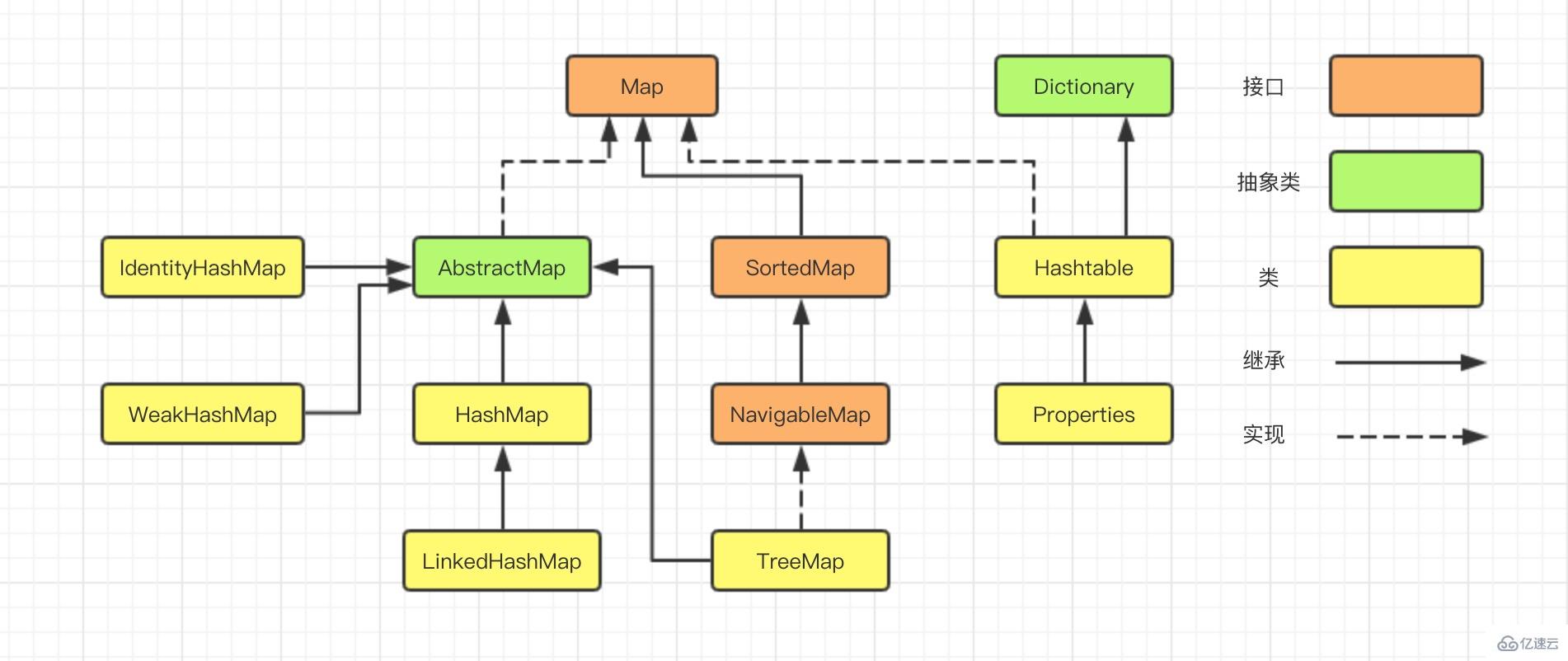这篇文章将为大家详细讲解有关LinkedHashMap的使用方法,小编觉得挺实用的,因此分享给大家做个参考,希望大家阅读完这篇文章后可以有所收获。
一、摘要
在集合系列的第一章,咱们了解到,Map的实现类有HashMap、LinkedHashMap、TreeMap、IdentityHashMap、WeakHashMap、Hashtable、Properties等等。

本文主要从数据结构和算法层面,探讨LinkedHashMap的实现。
二、简介
LinkedHashMap可以认为是HashMap+LinkedList,它既使用HashMap操作数据结构,又使用LinkedList维护插入元素的先后顺序,内部采用双向链表(doubly-linked list)的形式将所有元素( entry )连接起来。
LinkedHashMap继承了HashMap,允许放入key为null的元素,也允许插入value为null的元素。从名字上可以看出该容器是LinkedList和HashMap的混合体,也就是说它同时满足HashMap和LinkedList的某些特性,可将LinkedHashMap看作采用Linked list增强的HashMap。
打开 LinkedHashMap 源码,可以看到主要三个核心属性:
public class LinkedHashMap<K,V>
extends HashMap<K,V>
implements Map<K,V>{
/**双向链表的头节点*/
transient LinkedHashMap.Entry<K,V> head;
/**双向链表的尾节点*/
transient LinkedHashMap.Entry<K,V> tail;
/**
* 1、如果accessOrder为true的话,则会把访问过的元素放在链表后面,放置顺序是访问的顺序
* 2、如果accessOrder为false的话,则按插入顺序来遍历
*/
final boolean accessOrder;
}LinkedHashMap 在初始化阶段,默认按插入顺序来遍历
public LinkedHashMap() {
super();
accessOrder = false;
}LinkedHashMap 采用的 Hash 算法和 HashMap 相同,不同的是,它重新定义了数组中保存的元素Entry,该Entry除了保存当前对象的引用外,还保存了其上一个元素before和下一个元素after的引用,从而在哈希表的基础上又构成了双向链接列表。
源码如下:
static class Entry<K,V> extends HashMap.Node<K,V> {
//before指的是链表前驱节点,after指的是链表后驱节点
Entry<K,V> before, after;
Entry(int hash, K key, V value, Node<K,V> next) {
super(hash, key, value, next);
}
}
可以直观的看出,双向链表头部插入的数据为链表的入口,迭代器遍历方向是从链表的头部开始到链表尾部结束。

除了可以保迭代历顺序,这种结构还有一个好处:迭代LinkedHashMap时不需要像HashMap那样遍历整个table,而只需要直接遍历header指向的双向链表即可,也就是说LinkedHashMap的迭代时间就只跟entry的个数相关,而跟table的大小无关。
三、常用方法介绍
3.1、get方法
get方法根据指定的key值返回对应的value。该方法跟HashMap.get()方法的流程几乎完全一样,默认按照插入顺序遍历。
public V get(Object key) {
Node<K,V> e;
if ((e = getNode(hash(key), key)) == null)
return null;
if (accessOrder)
afterNodeAccess(e);
return e.value;
}如果accessOrder为true的话,会把访问过的元素放在链表后面,放置顺序是访问的顺序
void afterNodeAccess(Node<K,V> e) { // move node to last
LinkedHashMap.Entry<K,V> last;
if (accessOrder && (last = tail) != e) {
LinkedHashMap.Entry<K,V> p =
(LinkedHashMap.Entry<K,V>)e, b = p.before, a = p.after;
p.after = null;
if (b == null)
head = a;
else
b.after = a;
if (a != null)
a.before = b;
else
last = b;
if (last == null)
head = p;
else {
p.before = last;
last.after = p;
}
tail = p;
++modCount;
}
}测试用例:
public static void main(String[] args) {
//accessOrder默认为false
Map<String, String> accessOrderFalse = new LinkedHashMap<>();
accessOrderFalse.put("1","1");
accessOrderFalse.put("2","2");
accessOrderFalse.put("3","3");
accessOrderFalse.put("4","4");
System.out.println("acessOrderFalse:"+accessOrderFalse.toString());
//accessOrder设置为true
Map<String, String> accessOrderTrue = new LinkedHashMap<>(16, 0.75f, true);
accessOrderTrue.put("1","1");
accessOrderTrue.put("2","2");
accessOrderTrue.put("3","3");
accessOrderTrue.put("4","4");
accessOrderTrue.get("2");//获取键2
accessOrderTrue.get("3");//获取键3
System.out.println("accessOrderTrue:"+accessOrderTrue.toString());
}输出结果:
acessOrderFalse:{1=1, 2=2, 3=3, 4=4}
accessOrderTrue:{1=1, 4=4, 2=2, 3=3}3.2、put方法
put(K key, V value)方法是将指定的key, value对添加到map里。该方法首先会调用HashMap的插入方法,同样对map做一次查找,看是否包含该元素,如果已经包含则直接返回,查找过程类似于get()方法;如果没有找到,将元素插入集合。
/**HashMap 中实现*/
public V put(K key, V value) {
return putVal(hash(key), key, value, false, true);
}
final V putVal(int hash, K key, V value, boolean onlyIfAbsent,
boolean evict) {
Node<K,V>[] tab; Node<K,V> p; int n, i;
if ((tab = table) == null || (n = tab.length) == 0)
n = (tab = resize()).length;
if ((p = tab[i = (n - 1) & hash]) == null)
tab[i] = newNode(hash, key, value, null);
else {
Node<K,V> e; K k;
if (p.hash == hash &&
((k = p.key) == key || (key != null && key.equals(k))))
e = p;
else if (p instanceof TreeNode)
e = ((TreeNode<K,V>)p).putTreeVal(this, tab, hash, key, value);
else {
for (int binCount = 0; ; ++binCount) {
if ((e = p.next) == null) {
p.next = newNode(hash, key, value, null);
if (binCount >= TREEIFY_THRESHOLD - 1) // -1 for 1st
treeifyBin(tab, hash);
break;
}
if (e.hash == hash &&
((k = e.key) == key || (key != null && key.equals(k))))
break;
p = e;
}
}
if (e != null) { // existing mapping for key
V oldValue = e.value;
if (!onlyIfAbsent || oldValue == null)
e.value = value;
afterNodeAccess(e);
return oldValue;
}
}
++modCount;
if (++size > threshold)
resize();
afterNodeInsertion(evict);
return null;
}LinkedHashMap 中覆写的方法
// LinkedHashMap 中覆写
Node<K,V> newNode(int hash, K key, V value, Node<K,V> e) {
LinkedHashMap.Entry<K,V> p =
new LinkedHashMap.Entry<K,V>(hash, key, value, e);
// 将 Entry 接在双向链表的尾部
linkNodeLast(p);
return p;
}
private void linkNodeLast(LinkedHashMap.Entry<K,V> p) {
LinkedHashMap.Entry<K,V> last = tail;
tail = p;
// last 为 null,表明链表还未建立
if (last == null)
head = p;
else {
// 将新节点 p 接在链表尾部
p.before = last;
last.after = p;
}
}
3.3、remove方法
remove(Object key)的作用是删除key值对应的entry,该方法实现逻辑主要以HashMap为主,首先找到key值对应的entry,然后删除该entry(修改链表的相应引用),查找过程跟get()方法类似,最后会调用 LinkedHashMap 中覆写的方法,将其删除!
/**HashMap 中实现*/
public V remove(Object key) {
Node<K,V> e;
return (e = removeNode(hash(key), key, null, false, true)) == null ?
null : e.value;
}
final Node<K,V> removeNode(int hash, Object key, Object value,
boolean matchValue, boolean movable) {
Node<K,V>[] tab; Node<K,V> p; int n, index;
if ((tab = table) != null && (n = tab.length) > 0 &&
(p = tab[index = (n - 1) & hash]) != null) {
Node<K,V> node = null, e; K k; V v;
if (p.hash == hash &&
((k = p.key) == key || (key != null && key.equals(k))))
node = p;
else if ((e = p.next) != null) {
if (p instanceof TreeNode) {...}
else {
// 遍历单链表,寻找要删除的节点,并赋值给 node 变量
do {
if (e.hash == hash &&
((k = e.key) == key ||
(key != null && key.equals(k)))) {
node = e;
break;
}
p = e;
} while ((e = e.next) != null);
}
}
if (node != null && (!matchValue || (v = node.value) == value ||
(value != null && value.equals(v)))) {
if (node instanceof TreeNode) {...}
// 将要删除的节点从单链表中移除
else if (node == p)
tab[index] = node.next;
else
p.next = node.next;
++modCount;
--size;
afterNodeRemoval(node); // 调用删除回调方法进行后续操作
return node;
}
}
return null;
}LinkedHashMap 中覆写的 afterNodeRemoval 方法
void afterNodeRemoval(Node<K,V> e) { // unlink
LinkedHashMap.Entry<K,V> p =
(LinkedHashMap.Entry<K,V>)e, b = p.before, a = p.after;
// 将 p 节点的前驱后后继引用置空
p.before = p.after = null;
// b 为 null,表明 p 是头节点
if (b == null)
head = a;
else
b.after = a;
// a 为 null,表明 p 是尾节点
if (a == null)
tail = b;
else
a.before = b;
}
四、总结
LinkedHashMap 继承自 HashMap,所有大部分功能特性基本相同,二者唯一的区别是 LinkedHashMap 在HashMap的基础上,采用双向链表(doubly-linked list)的形式将所有 entry 连接起来,这样是为保证元素的迭代顺序跟插入顺序相同。
主体部分跟HashMap完全一样,多了header指向双向链表的头部,tail指向双向链表的尾部,默认双向链表的迭代顺序就是entry的插入顺序。
关于LinkedHashMap的使用方法就分享到这里了,希望以上内容可以对大家有一定的帮助,可以学到更多知识。如果觉得文章不错,可以把它分享出去让更多的人看到。
亿速云「云服务器」,即开即用、新一代英特尔至强铂金CPU、三副本存储NVMe SSD云盘,价格低至29元/月。点击查看>>
免责声明:本站发布的内容(图片、视频和文字)以原创、转载和分享为主,文章观点不代表本网站立场,如果涉及侵权请联系站长邮箱:is@yisu.com进行举报,并提供相关证据,一经查实,将立刻删除涉嫌侵权内容。